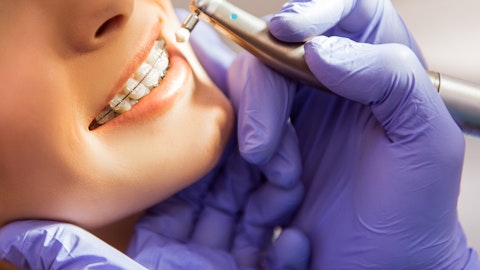So it’s a little bit of tale of two things. We need to make some short-term investments to reinvigorate growth in North American implants in particular. And then long-term, we need to look at opportunities to reduce costs. And we do see opportunities to reduce costs and be more efficient. We just need to be careful about where we’re being efficient. We are very efficient in SG&A — or sorry, G&A and then be making sure, we’re making the right sales and marketing investments.
Brandon Vasquez: Okay. And then maybe for my follow-up, switching gears a little bit to China. It looked like that was a nice growth area for you guys in implants. Can you just talk a little bit about where you’re seeing growth there? How sustainable that is in implants? And then conversely, I think we were talking last quarter about Ortho being — going under VBP in China in the second half of ’24. Is that still your expectation? And if so, can you talk about what the financial impact could be there? Thank you.
Amir Aghdaei: Yes, of course. In Q1, we saw our sales increase in China by over 50%. So of course, as we mentioned earlier, Q1 was really muted because of COVID and because of the VBP piece. But what is really, what we’re looking at is the number of implant placed. What we are seeing is — it was an easier comp in Q1, but what we’re seeing is a ramp-up of implant throughout China. And the reason for it are threefold. One, the price gap between the premium and that value part has been closed. Because of VBP. So it’s not that huge of a difference between the price. Second part is about the price of a placement implant now versus a three-unit bridge, it’s almost the same. So a lot of people now that see the value of doing a lifetime permanent solution versus a five to seven year.
And last but not least, more and more people are beginning to see the value of placing an implant as well as clinicians being able to do that. So we’re really bullish about the China potential implant in the long run. Not only on the premium side, but for the first time, our value brand, ABT is now accepted as part of VBP and five of the major universities and institutions, and that is growing as well. It’s an underpenetrated market with tremendous amount of potential. So it gives us a little bit of a feel for what we expect to see on the implant business in China. Our expectation right now — we don’t have any detail that we can share with you, but we were in China not long ago. We talked to a lot of customers. Their expectation is that the VBP for Ortho is going to be sometimes during the second half, but the approach that they took on the implant side really gave a tremendous amount of insight on how to manage this in a structured format.
We expect to see that in second half. We have contemplated. It is in our plan. And — but we think in the long-term, China continues to be a growth driver for Envista because of that under penetration, because of the capabilities and brand recognition that we have in China.
Operator: We’ll take our next question from Nathan Rich with Goldman Sachs. Please go ahead.
Nathan Rich: Hey, good afternoon, and thanks for the question. And Amir thanks for all the help over the years. And Paul, welcome to you, look forward to working with you. I wanted to ask on the consumables business. I think outside the US, you talked about a bit — maybe some weaker demand that you’re seeing. Could you maybe elaborate on what you saw in the quarter? Were there specific geographies that you would highlight? And then I think you also talked about kind of actively managing price in some of those markets. Could you maybe just expand there? Are you seeing dentistry down? Is that something where you feel like you have to adjust pricing? Any color you can share there would be great.
Amir Aghdaei: Thank you, Nate. Let me start from the pricing perspective. It’s normally because of the relationship and partnership that we have with our partners and distributors normally prices don’t happen radically. We give them notice, 30 to 90 days in advance. So it’s a little bit of a different lay of the land in here compared to like implant and Ortho. So we continue to see good price position. We have a great relationship with our partners. We have — as Stephen talked about, we have made some investment in the key supplier program. But what we saw in Q4 because of the cybersecurity issues, there was a little bit of a delay that we saw in Q1. Our infection prevention grew mid-single-digit in Q1. And a lot of it was because of the medical channel.
We saw a significant increase, not only on growth but also on the pricing part. Our Restorative Endo business was more flat. And after a decline in double-digit in Q4, we saw a flat approach. And given the fact that we are able to really perform and deliver well in here, inventories continue to be really well managed by our partners across the board. We continue to see really good sell-out information and our solution where we have that information, we are outperforming the market. But on the geography side, we have been very focused. A good portion of our business comes in North America, and we continue to see momentum in there. In Europe, a couple of issues in Europe. We had a day and a half, two days less working day in Q1 because where Easter followed — fall in Q1.
So we had a little bit of a challenge in there, but not necessarily because of the sellout. It was because of the timing of it. We’ll continue to be pretty bullish about our Resto Endo business. We think that we’ve got good performance, great product, great relationships with our distributors. And we think this is going to bounce back up as we go throughout the world. And we think that outperformance that we have seen in most markets around the world is going to continue as we go through 2024.
Nathan Rich: Great. That’s helpful. Maybe just as a quick follow-up. Are you able to give us sort of a rough sense of the timeline we should expect for the searches that you have underway for CFO and the Nobel roles. Is that something that got us underway now that Paul has joined. Or have these kind of been in process. Just — I know it’s probably hard to say specifically, but anything you can add there would be great.
Amir Aghdaei: Of course, Nate. We have a really active search underway. And given the transition of CEO, there was a little bit of a delay in here because as you can imagine, CFO is really like to know who they work with, who they partner with. But we have a number of strong candidates in here, Paul and the Board have been actively involved. Now that we have a permanent and CEO in place, I think we can accelerate that really quickly. Paul’s appointment is going to really help with the top talent and candidate to come for both on the CFO search as well as on the Nobel side. We have an active search underway for the position in the Nobel. Nobel is an incredible brand. We’re seeing a lot of people of top talent coming forward. And I’ll leave it to Paul and the management team to communicate as they go forward to make sure that we are continuing to build on the momentum that we have in here and continue to build this legacy for years to come.
Nathan Rich: Thank you.
Operator: This does conclude our Q&A session. I’ll turn the program back to Stephen Keller for any closing comments.
Stephen Keller: Thanks, everyone. I really appreciate the time today. Look, obviously, we will be setting up time for investors with Paul at a later date once he’s had a chance to fully get involved in the business. We’re looking forward to working with you all in the coming quarters and years. Thank you so much.
Operator: This does conclude today’s program. Thank you for your participation and you may now disconnect.
Follow Envista Holdings Corp (NYSE:NVST)
Follow Envista Holdings Corp (NYSE:NVST)
Receive real-time insider trading and news alerts



